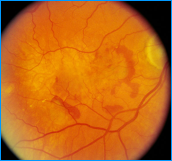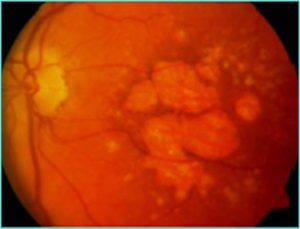Exposure to pesticides has always been a hot public health issue and recent clinical studies have raised a new concern: the link between exposure to organophosphorus pesticides and the risk of age-related macular degeneration (AMD).
DAP and PPO
In one study published in the International Journal of Ophthalmology (IJO), researchers from Shanghai General Hospital, led by Dr Yu-Xin Jiang, examined the impact of urinary metabolites of the dialkyl phosphate (DAP) on AMD, showing an increased risk for those exposed to organophosphorus pesticides (OPP).
In fact, some orthophosphorus pesticides are rapidly absorbed, metabolised and eliminated from the body in the urine as dialkyl phosphate metabolites.
Urinary DAP metabolites were used to build a machine learning model to quantify the effect of exposure to organophosphorus pesticides on DMLE risk.
Impacts on Health and the Environment
The harmful effects of PPOs are not limited to the eyes, as these pesticides pose significant health risks to the entire body, as they are rapidly absorbed and metabolised in the human body.
Their nature non-biodegradable also makes them particularly dangerous for the environment.
PPO residues accumulate in soil and water, adversely affecting ecosystems. Absorption occurs through ingestion, inhalation and skin contact, posing serious risks to human health.
Metabolites and Biomarkers
DAP urinary metabolites are used as biomarkers to assess exposure to organophosphorus pesticides. These biomarkers offer an indirect but reliable measure of exposure levels.
The use of biomarkers allows scientists to monitor exposure in different populations and the ability to detect PPO body burden through non-invasive methods represents a significant advance in epidemiological research, facilitating large-scale studies and preventive interventions.
Risk Factors for Macular Degeneration
 AMD is a complex disease, the onset of which has been linked to a multiplicity of risk factors including advancing age, genetic factors, lifestyle and environmental factors.
AMD is a complex disease, the onset of which has been linked to a multiplicity of risk factors including advancing age, genetic factors, lifestyle and environmental factors.
Genetic factors can predispose individuals to AMD, while habits such as smoking and poor diet can exacerbate the risk. Exposure to environmental chemicals, such as pesticides, adds another level of risk.
Among environmental factors, exposure to organophosphorus PPO pesticides is particularly relevant since their use is very common in agriculture and they are known to have toxic effects on human health, and their persistent accumulation in the environment raises concerns.
Understanding these factors not only helps in prevention, but also in therapy management, potentially improving the quality of life for those affected by the disease.
Current therapies for AMD
In the dry form (non-neovascular) of AMD, the importance of using appropriately formulated dietary supplements to slow down the progression of the disease, as recommended by the 'Guidelines' of the American Academy of Ophthalmology (A.A.O.), the official reference body of ophthalmologists worldwide, is well established.
Dietary supplements developed to counter the progression of AMD contain:
- vitamin C and vitamin E, which act by slowing down the processes of ageing and cell degeneration caused by the production of free radicals.
- zinc, implicated in numerous enzymatic activities, localised at the retinal level.
- copper, a trace element essential for the activity of numerous enzymes, always supplements zinc intake.
- lutein and zeaxanthin, carotenoids that accumulate in the central part of the retina (the macula lutea), forming the macular pigment, an important protective screen of the eye.
- astaxanthin, the most powerful naturally occurring antioxidant also endowed with anti-inflammatory and anti-angiogenic activity.
- ω-3 fatty acids, called 'essential' because they cannot be synthesised by the body, but must only be ingested through the diet. Main constituents of the photoreceptor outer membrane, they have anti-inflammatory and anti-angiogenic activity.
Numerous preclinical and clinical studies have demonstrated the protective effects of all these components against the risk of AMD progression.
 For the treatment of wet form (neovascular) There are now numerous treatment options, from traditional ones such as laser photocoagulation and photodynamic therapy (PDT) to the more recent anti-angiogenic drug therapy. Laser photocoagulation consists of focusing a particularly powerful laser beam to destroy abnormal vessels that form in the retina. In some cases, it is then possible to use photodynamic therapy (PDT), which selectively destroys abnormal blood vessels through the intravenous injection of a photosensitive drug substance that is activated by laser treatment.
For the treatment of wet form (neovascular) There are now numerous treatment options, from traditional ones such as laser photocoagulation and photodynamic therapy (PDT) to the more recent anti-angiogenic drug therapy. Laser photocoagulation consists of focusing a particularly powerful laser beam to destroy abnormal vessels that form in the retina. In some cases, it is then possible to use photodynamic therapy (PDT), which selectively destroys abnormal blood vessels through the intravenous injection of a photosensitive drug substance that is activated by laser treatment.
The important and revolutionary therapeutic innovation was the administration by intravitreal injection of certain anti-angiogenic substances (pegaptanib, ranibizumab, bevacizumab, aflibercept), which are able to counteract the formation of neovases and also promote the reabsorption of neovases that have already formed.
Machine learning and research
Recent research has used machine learning models to better understand the risk factors for AMD.
A machine learning model was used to analyse data on DAP metabolites and predict the risk of AMD.
Machine learning models have been trained on large data sets to identify correlations and predict results with high accuracy. The use of algorithms such as Random Forests provided optimal performance.
Importance of Exposure Characteristics
The analysis of exposure characteristics was crucial to understanding the risk of AMD. Statistical models highlighted the significant weight of DAP metabolites in risk prediction.
Machine learning models have used techniques such as the Permutation Feature Importance (PFI) and the SHapley Additive exPlanations (SHAP) to assess the impact of the different variables.
These analyses showed that DAP metabolites have a greater influence than most sociodemographic covariables, underlining the importance of environmental exposures.
Interpretation of Results
The interpretation of the results showed the importance of 6 DAP metabolites in predicting the risk of AMD. Graphic and statistical analysis supported these results.
- I Shapley values and the cascading graphs have highlighted the predictive capacity of machine learning models.
- The reports displayed by the graphs illustrated the indispensable effects of the six DAP metabolites in the risk of AMD.
Public Health Implications
The findings on the effects of organophosphorus pesticides have significant public health implications, highlighting the need for tighter regulations and prevention strategies.
To reduce the risk of AMD and other adverse effects of pesticides, several preventive strategies are recommended:
- Promoting the use of alternative pesticides less harmful.
- Implement stricter regulations on the use of pesticides.
- Educate the public on the risks associated with pesticides and how to reduce exposure.
Conclusions and Future Perspectives
Research has shown the critical connection between environmental factors and visual health, emphasising the importance of considering these influences in the management of AMD.
The machine learning algorithms show great potential in risk prediction of AMD and other medical applications, improving clinical decision-making.
- They offer more accurate forecasts through the analysis of large amounts of data.
- They make it possible to identify high-risk individuals for early intervention.
These tools are destined to become an integral part of future medical research and clinical practice.
Directions for Future Studies
Future studies should focus on additional insights connections between environmental exposures and health, exploiting new technologies and research methodologies.
- Expanding the research on a global scale to understand regional variations in risks.
- Integrating new biomarkers and analysis techniques to improve search accuracy.
These indications can help to improve public health and reduce the incidence of diseases related to environmental factors.
- Jiang YX, Gui SY, Sun XD. Associations between organophosphorus pesticides exposure and age-related macular degeneration risk in U.S. adults: analysis from interpretable machine learning approaches. Int J Ophthalmol. 2025 Jul 18;18(7):1214-1230. doi: 10.18240/ijo.2025.07.04. PMID: 40688783; PMCID: PMC12207304.
- Fleckenstein M, Schmitz-Valckenberg S, Chakravarthy U. Age-related macular degeneration: a review. JAMA. 2024;331(2):147-157. doi: 10.1001/jama.2023.26074.
- Liu L, Li C, Yu HH, et al. A critical review on air pollutant exposure and age-related macular degeneration. Sci Total Environ. 2022;840:156717. doi: 10.1016/j.scitotenv.2022.156717.
